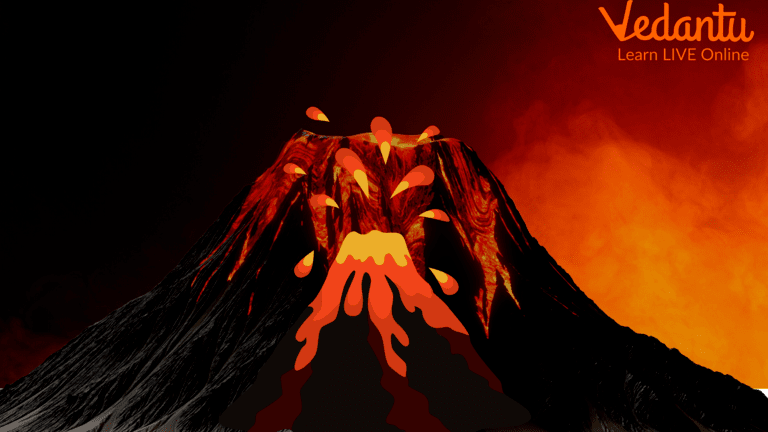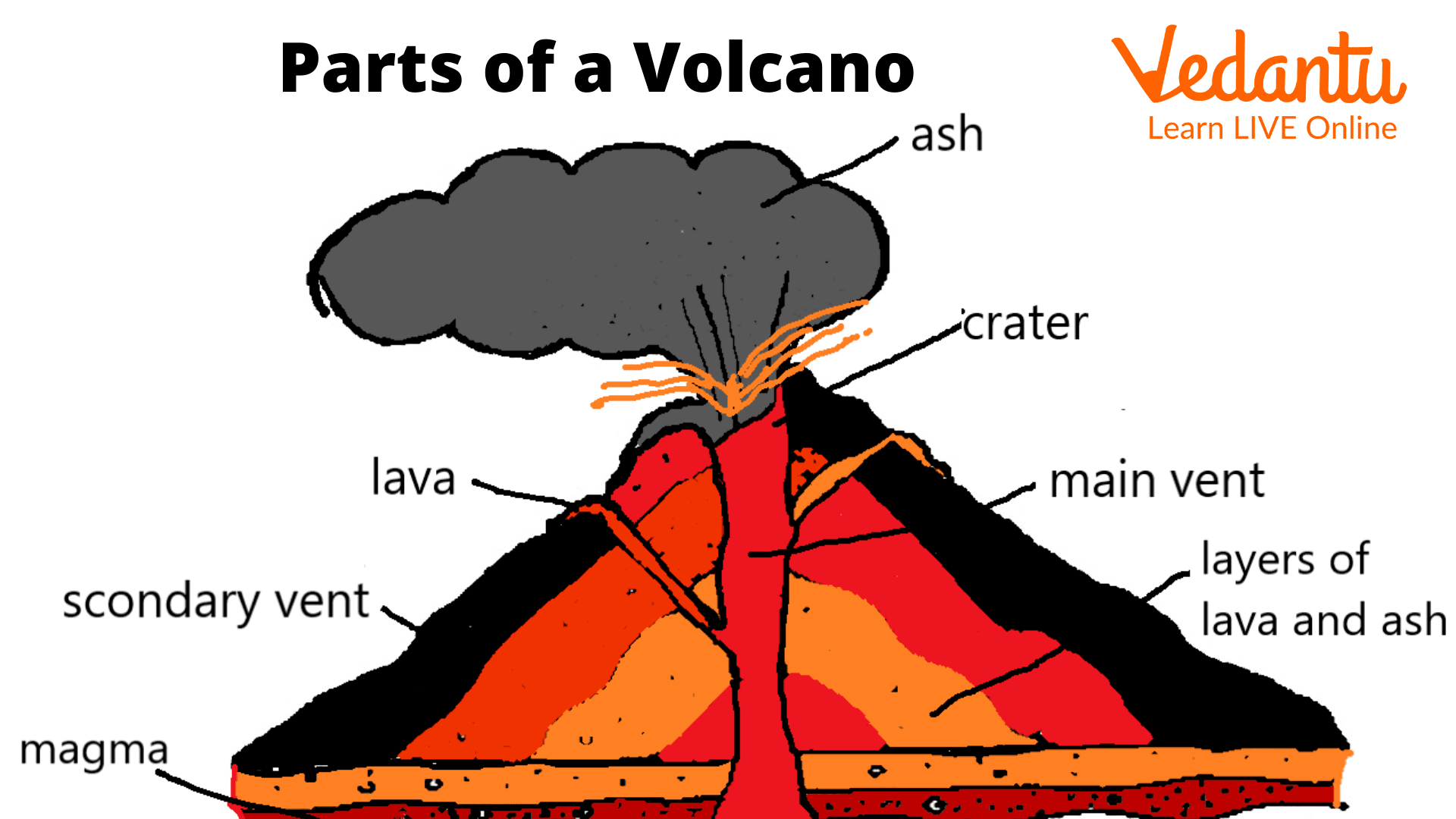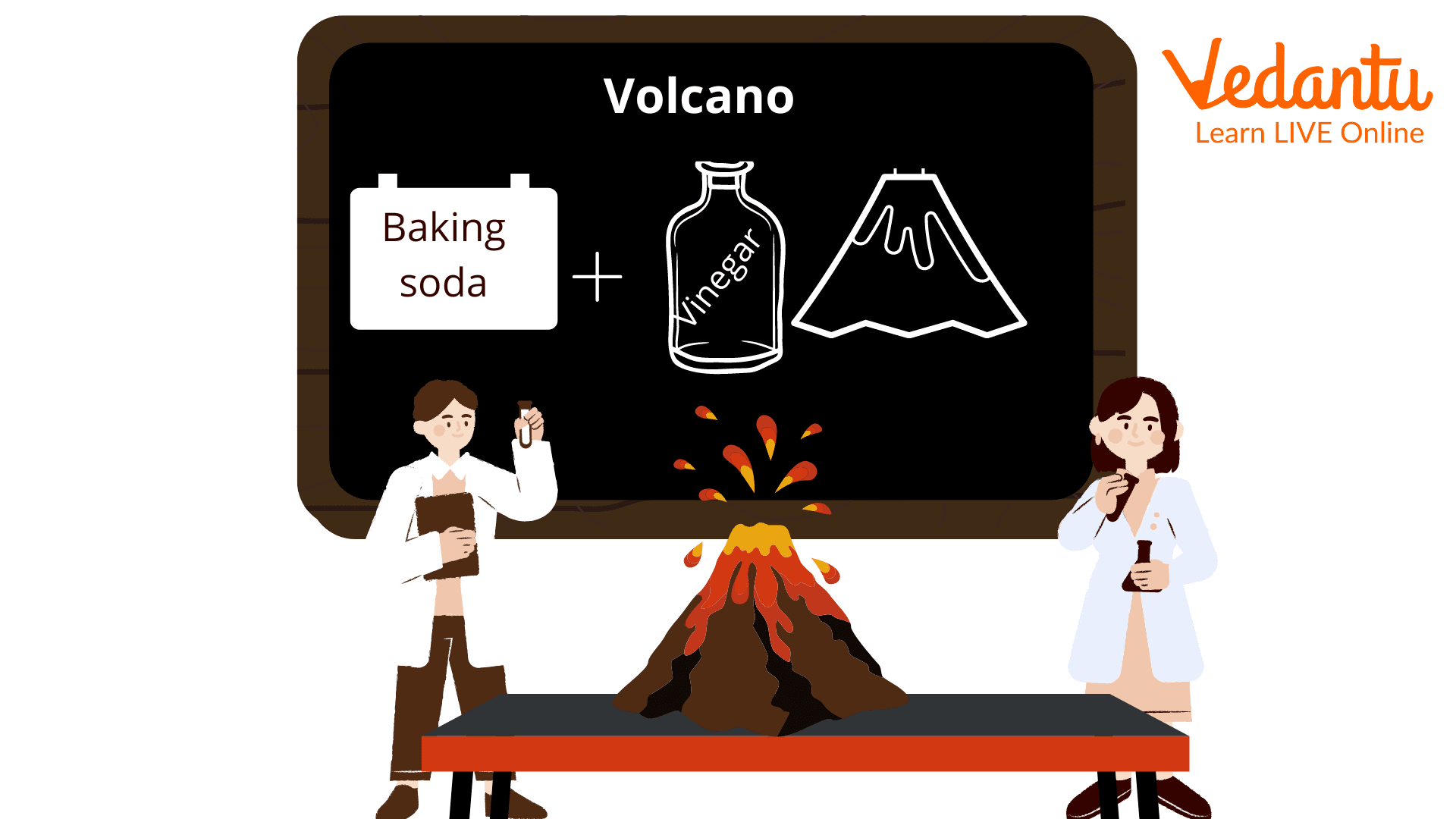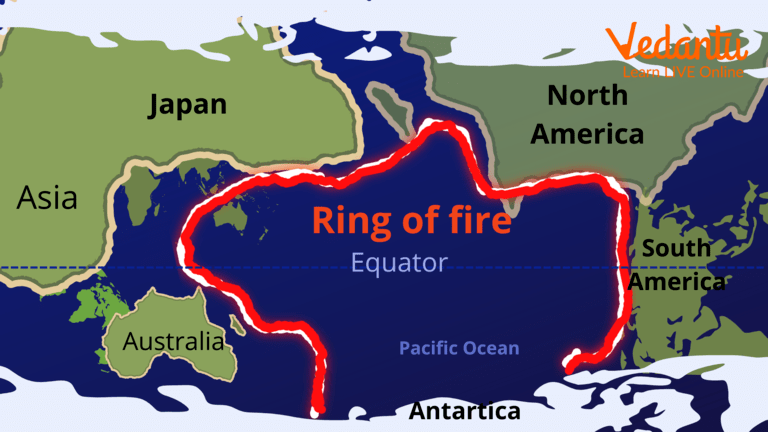




What is a Volcano?
Have you ever watched fire and smoke erupting out of the mountain, in movies? Well, it is actually a volcano. You can imagine a volcano as a hole in the earth from which molten rock and gas from deep inside the earth come out. It is like a mountain of fire on the earth’s surface.
When a volcano erupts, it can cause earthquakes, tsunamis, flash floods, and rockfalls. Volcanoes are dangerous as the hot lava can kill people and damage landscape and property.

An Erupting Volcano for Kids
The phenomenon of volcanoes sounds interesting, right? So, why wait? Let’s know more about volcano for kids.
How is a Volcano Formed?
To simply explain the formation of a volcano for kids, it is formed when two tectonic plates either move apart or come together. Tectonic plates are huge, irregularly shaped slabs of rock pieces that make up the Earth’s crust.
The movement of the plates forces the molten material inside the Earth to move and rise through the cracks on the Earth's crust. When the molten rocks come out through the cracks, volcanoes are formed over time. Most volcanoes are situated along the boundaries of tectonic plates.
Terms Related to Volcano for Kids
Let’s have a look at some of the common terms related to volcanoes that will help you understand them better.
Vent – It is like the main path in a volcano through which magma and gases travel from deep inside the Earth to its surface.
Crater – It is a bowl-shaped area at the top of a volcano’s vent.
Magma Chamber – It is a pool of magma below the volcano’s vent.
Active Volcano – It is a volcano that erupts frequently.
Dormant Volcano – It is a volcano that has not erupted in the past many years, but it could again any time.
Extinct Volcano – It is a volcano that has not erupted in thousands of years, and it will not erupt again in the future.
Volcanologists – They are scientists who study volcanoes.

Parts of a Volcano
Types of Volcano
Geologists typically divide volcanoes into four categories: cinder cones, composite volcanoes, shield volcanoes, and lava domes.
Cinder Cone - Volcanoes with cinder cones are the most basic. They are made of lava chunks and blobs discharged from the base. A cone-shaped formation is created as the gas-charged lava violently pushes into the air. Few cinder cones rise above a thousand feet.
Composite Volcano - Compound volcanoes, known as stratovolcanoes, are responsible for some of the world's tallest mountains. They are often enormous, symmetrical cones with steep sides made of varying cinders, stones, bombs, volcanic ash, and lava.
Shield Volcano - The third form of the volcano is a shield volcano, composed mainly of flowing lava. A central summit vent, or set of vents, releases flow after flow in all directions, creating a broad, gently sloping cone of flat, domical shape with a profile resembling a warrior's shield. Shield volcanoes are some of the world's most enormous volcanoes.
Lava Domes - Volcanoes or lava domes are created when relatively tiny, bulbous masses of lava extrude from their vents because they are too viscous to flow very far. A crown expands primarily from within as it grows; its outer surface cools, hardens, and eventually breaks, spewing loose pieces down its sides.
What Causes Volcanoes?
Volcanoes on land develop when one tectonic plate slides beneath another. A thinner, heavier oceanic plate typically subducts beneath a more comprehensive continental plate.
In this plate, water trapped in the rocks is forced out. A few of the rocks melt as a result of this. Because it is thinner than the surrounding rock, the melted rock, or magma, rises.
When the magma chamber becomes sufficiently overfilled, the magma forces its path to the surface and explodes, frequently resulting in volcanic eruptions.
A Volcano Eruption Process
Fun Facts About Volcanoes
Volcanoes are surface-level fissures on the Earth. When they are active, they can erupt violently and spectacularly, spewing ash, gas, and hot magma into the air.
The name of the Roman god of fire, Vulcan, is where the word "volcano" first appeared.
While most volcanoes form close to tectonic boundaries, they can develop in regions where the Earth's interior contains a boiling rock.
Typical volcanic gases include water vapour, carbon dioxide, sulfur dioxide, hydrogen chloride, fluoride, and hydrogen sulfide.
Ash from volcanic eruptions can travel more than 30 kilometres above the Earth's surface.
Characteristics of Volcanoes
Lava and ash outbursts give rise to volcanoes.
Volcanoes are often cone-shaped hills or ranges.
Lava is magma that has reached the Earth's surface.
Volcanic eruptions can occur at disruptive and constructive boundaries.
Make Your Own Volcano!
Yes, you heard that right, you can make your own volcano! Let’s see how.

Making a Volcano for Kids
Things You Will Need
10 ml liquid soap
100 ml warm water
400 ml white vinegar
Half cup baking soda, which is half-filled with water
Red food colouring
A big empty soda bottle
What You Need to Do
First, mix the soap, water, and vinegar together. Then add a few drops of food colouring into the empty soda bottle. Pour the mixture into the bottle. Now, pour the baking soda from the cup and step back immediately!
It's erupting! Your mini volcano will erupt immediately due to a reaction between the vinegar and baking soda. Enjoy watching your volcano erupt!
Conclusion
Volcano for kids describes the natural phenomena in an easy and interesting way for children. These geographical concepts are important for kids as they are the basic natural phenomenon and children should know what is around them. For more concepts which are explained in an easy manner as this volcano for kids, you can explore through our website. You will be amazed to find a treasure of resources!
FAQs on Volcano for Kids - Easy Explanation with Fun Activity
1. What is the Ring of Fire?
Almost more than half of the world’s volcanoes are located in a belt around the Pacific Ocean, along the boundary of its tectonic plate. This huge circle of volcanoes is called the Pacific Ring of Fire.

The Ring of Fire
2. What is the difference between lava and magma?
Magma is the hot, liquid rock present inside the earth. It glows bright orange in colour, whereas lava is the hot, liquid rock that flows out of a volcano. In simple words, when magma comes out on the Earth’s surface from a volcano, it is called lava. Fresh lava glows red hot to white-hot as it cools.
3. How did a volcano form?
When boiling, molten rock, ash, and gases seep from a crack in the Earth's crust, a volcano is produced. As the molten lava and ash cool, they solidify and take on the unique shape of a volcano, as seen above. Lava spews from a volcano's eruption and flows downhill.
4. What is housed within a volcano?
Magma, or molten rock, accumulates in a chamber inside an active volcano. The magma escapes onto the planet's surface through tunnels in the rock due to pressure building up within the magma chamber.
5. How many volcanoes are out there?
Aside from the continuous bands of volcanoes on the sea floor at spreading hubs like the Mid-Atlantic Ridge, there are around 1,350 possibly active volcanoes worldwide.









